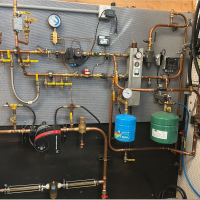Best Of
Re: 1/2" sweat to 3/4" Male NPT brass adapter?
That looks more like a very minor leak thats causing the corrosion.
 pecmsg
pecmsg
Re: 1/2" sweat to 3/4" Male NPT brass adapter?
I am not in favor of bushings they tend to leak. I would come out with a short brass nipple with a 3/4 x 1/2 brass coupling.
And alternative is a copper female x brass male union.
What ever you do swest to the fittings before you screw them into the coil. Don't screw the fittings in and sweat to them you will cook the pipe dope and the coil will suck up the torch heat making soldering more difficult.
Re: 1/2" sweat to 3/4" Male NPT brass adapter?
Why not simply put a 3/4 x1/2” brass bushing on the coil. Then use a 1/2” cu. male adapter?
You’re making it much harder than it is.
You should also have unions as close to the coil as possible and a valving arrangement for cleaning. Get a tankless valve kit, a couple of bushings and brass nipples, and you’ll have everything you need to do it right.
 Ironman
Ironman
Re: 1/2" sweat to 3/4" Male NPT brass adapter?
Hi, I'm not answering your question directly, but do have a suggestion for preventing further corrosion and making servicing easier. I'd consider coming from the coil in plastic lined steel nipples and then brass unions. From the unions, go to copper. This approach puts distance between different metals and makes access simpler, should things ever need servicing. Here's one brand:
Yours, Larry
Re: Replaced 128 year old galvanized DWV
Just the construction. The pipes were buried in original plaster & lathe. Homes that plumbing was added later are often run exposed in stairwells, et cetera. The Durham System (Galvanized Cast Iron drainage, waste and vent systems) were starting to go in during the 1870s & 1880s from my experience in the 5 Boros...Mad Dog 🐕
Re: 80°F when set to 70°F @ 107°F outside: dual zone mitsubishi heat pumps
I believe those 2 models are rated at .3 Static Pressure.
not going to get those #’s with old ducts.
 pecmsg
pecmsg
My Father’s American Dream
In this episode, Dan Holohan shares stories about growing up on Long Island, NY in the 1950s, the bungalow his dad built, and hydronic heating.
Re: What is this?
Typically on a steam boiler, there would not be a PRV before the BFP unless the standing pressure was extremely high, say over 80 PSI.
Re: What is this?
A dual check, vented backflow device. Usually there is a pressure reducing valve combined with it, if it is used as a boiler feed?
 hot_rod
hot_rod
Re: What is this?
It is an easy replacement at the backflow preventer has union connections at both ends. Just buy the same model and replace it. No soldering needed.


